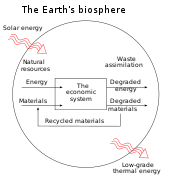 Global Information
Global InformationWeak and strong sustainability information
This article has multiple issues. Please help improve it or discuss these issues on the talk page. (Learn how and when to remove these template messages)
|
| Part of a series on |
| Ecological economics |
|---|
 |
Although related, sustainable development and sustainability are two different concepts. Weak sustainability is an idea within environmental economics which states that 'human capital' can substitute 'natural capital'. It is based upon the work of Nobel laureate Robert Solow,[1][2][3] and John Hartwick.[4][5][6] Contrary to weak sustainability, strong sustainability assumes that 'human capital' and 'natural capital' are complementary, but not interchangeable.
This idea received more political attention as sustainable development discussions evolved in the late 1980s and early 1990s. A key landmark was the Rio Summit in 1992 where the vast majority of nation-states committed themselves to sustainable development. This commitment was demonstrated by the signing of Agenda 21, a global action plan on sustainable development.
Weak sustainability has been defined using concepts like human capital and natural capital.[7] Human (or produced) capital incorporates resources such as infrastructure, labour and knowledge. Natural capital covers the stock of environmental assets such as fossil fuels, biodiversity and other ecosystem structures and functions relevant for ecosystem services. In very weak sustainability, the overall stock of man-made capital and natural capital remains constant over time. It is important to note that, unconditional substitution between the various kinds of capital is allowed within weak sustainability. This means that natural resources may decline as long as human capital is increased. Examples include the degradation of the ozone layer, tropical forests and coral reefs if accompanied by benefits to human capital. An example of the benefit to human capital could include increased financial profits.[8] If capital is left constant over time intergenerational equity, and thus Sustainable Development, is achieved.[9] An example of weak sustainability could be mining coal and using it for production of electricity. The natural resource coal, is replaced by a manufactured good which is electricity. The electricity is then in turn used to improve domestic life quality (e.g. cooking, lighting, heating, refrigeration and operating boreholes to supply water in some villages) and for industrial purposes (growing the economy by producing other resources using machines that are electricity operated.)
Case studies of weak sustainability in practice have had both positive and negative results. The concept of weak sustainability still attracts a lot of criticism. Some even suggest that the concept of sustainability is redundant. Other approaches are advocated, including ‘social bequests’, which focus the attention away from neoclassical theory altogether.
Strong sustainability assumes that the economic and environmental capital is complementary, but not interchangeable. Strong sustainability accepts there are certain functions that the environment performs that cannot be duplicated by humans or human made capital. The ozone layer is one example of an ecosystem service that is crucial for human existence, forms part of natural capital, but is difficult for humans to duplicate.[10]
Unlike weak sustainability, strong sustainability puts the emphasis on ecological scale over economic gains. This implies that nature has a right to exist and that it has been borrowed and should be passed on from one generation to the next still intact in its original form.
An example of strong sustainability could be the manufacturing of office carpet tiles from used car tyres. In this scenario, office carpets and other products are manufactured from used motorcar tires that would have been sent to a landfill.[11]
- ^ Solow, R.M. (1974). "Intergenerational equity and exhaustible resources". Review of Economic Studies. 41: 29–46. doi:10.2307/2296370. hdl:1721.1/63764. JSTOR 2296370.
- ^ Solow, R.M. (1986). "On the intergenerational allocation of natural resources". Scandinavian Journal of Economics. 88 (1): 141–9. doi:10.2307/3440280. JSTOR 3440280.
- ^ Solow, R.M. (1993). "An almost practical step towards sustainability". Resources Policy. 16 (3): 162–72. Bibcode:1993RePol..19..162S. doi:10.1016/0301-4207(93)90001-4.
- ^ Hartwick, J.M. (1977). "Intergenerational equity and the investing of rents from exhaustible resources". The American Economic Review. 67 (5): 972–4.
- ^ Hartwick, J.M. (1978a). "Investing returns from depleting renewable resource stocks and intergenerational equity". Economics Letters. 1 (1): 85–8. doi:10.1016/0165-1765(78)90102-7.
- ^ Hartwick, J.M. (1978b). "Substitution among exhaustible resources and intergenerational equity". The Review of Economic Studies. 45 (2): 347–54. doi:10.2307/2297349. JSTOR 2297349.
- ^ Cabeza-Gutes, M. (1996). "The concept of weak sustainability". Ecological Economics. 17 (3): 147–56. doi:10.1016/s0921-8009(96)80003-6.
- ^ Cart, N. (2001). The Politics of the Environment. Cambridge: Cambridge University Press.
- ^ Figge, F. (2005). "Capital Substitutability and Weak Sustainability Revisited: The Conditions for Capital Substitution in the Presence of Risk". Environmental Values. 14 (2): 185–201. doi:10.3197/0963271054084966.
- ^ "Sustainability continued". Archived from the original on August 26, 2012. Retrieved May 20, 2013.
- ^ "The business logic of sustainability".